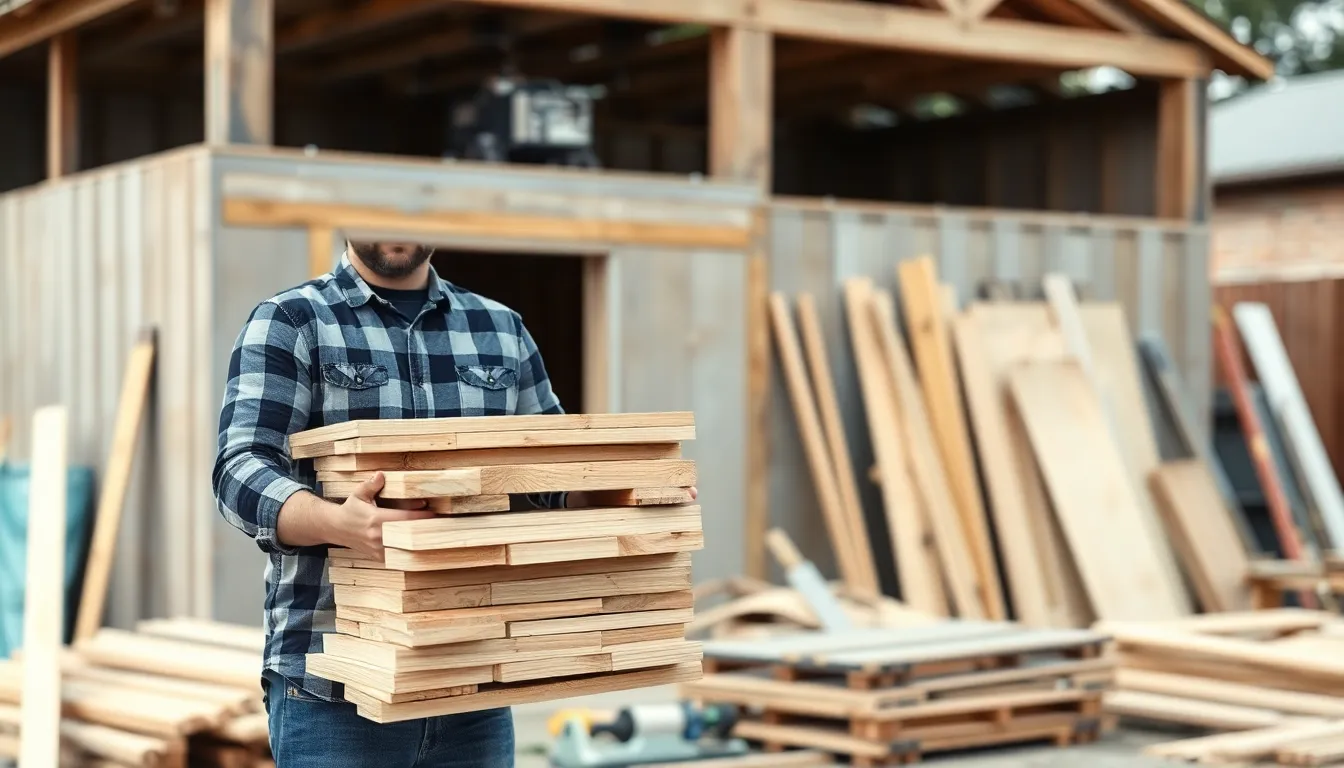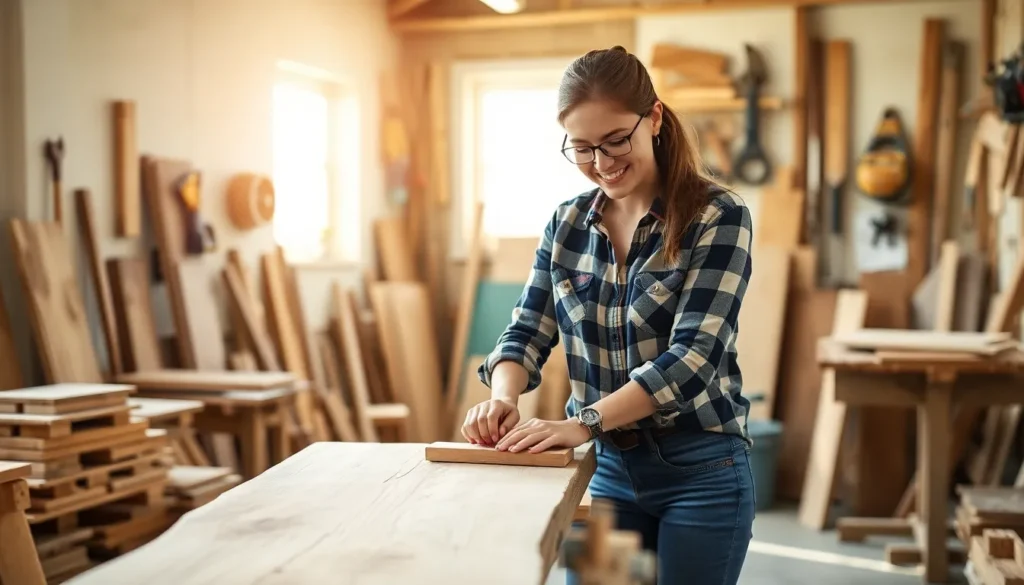Got a pile of scrap wood gathering dust in the garage? It’s time to turn that neglected lumber into cash! DIY scrap wood projects are not just a fun way to unleash creativity; they can also boost your bank account. From quirky home decor to practical furniture, there’s a world of possibilities waiting to be explored.
Table of Contents
TogglePopular DIY Scrap Wood Projects That Sell
Many people turn scrap wood into sought-after products. These projects attract buyers due to their unique appeal and functionality.
Rustic Furniture
Rustic furniture made from scrap wood proves popular in the market. Items like tables, benches, and shelves gain attention for their charm. Customized designs often stand out, with unique finishes enhancing their aesthetic. Each piece showcases the natural beauty of wood grains, demonstrating craftsmanship. Retailers can charge a premium for bespoke options, appealing to consumers seeking originality.
Home Decor Items
Home decor items crafted from scrap wood find strong demand. Wall art, picture frames, and decorative signs transform spaces effortlessly. Seasonal decor made from reclaimed materials also captures interest. Each piece can reflect personal style while maintaining eco-friendly practices. Offering a variety of designs, including farmhouse themes or modern styles, helps reach diverse customer preferences.
Tips for Sourcing Scrap Wood


Explore local construction sites to find excess materials from recent projects. Often, contractors are willing to let go of surplus wood at low or no cost. Check with local furniture stores that might discard imperfect items or remnants from custom jobs. Many retailers appreciate when individuals take their unwanted materials.
Visit hardware stores that offer cutting services. Some may provide leftover wood pieces at discounted prices or even for free. Reach out to community groups or neighborhood forums where homeowners post about renovations. These platforms can connect individuals with those wanting to give away excess wood.
Attend demolition sales or auctions that feature old buildings. These venues often have reclaimed wood available for those interested in unique textures and styles. Consider recycled building supply stores as well. These shops specialize in salvaged materials, offering a variety of wood options.
Network with friends and family who tackle home improvement projects. They might have scrap wood they’re willing to pass on. Look for local woodworking clubs or maker spaces. Being part of these communities can provide access to scrap wood and inspiration for new projects.
Join online marketplaces or apps dedicated to free items. Many individuals list extra materials that could benefit DIY enthusiasts. Participate in local events that encourage recycling and upcycling, which often promote the sharing of resources.
Keep an eye on seasonal clean-up days. Communities sometimes offer bulk pick-up services, where scrap wood can be found at curbsides. Investigate previous projects listed on social media platforms for additional leads.
Crafting Techniques for Success
Crafting scrap wood projects requires specific techniques that enhance both functionality and aesthetic appeal. Successful projects combine the right tools and finishing touches for optimal results.
Essential Tools and Materials
Essential tools include a circular saw for precise cuts, a miter saw for angled pieces, and a drill for making holes and driving screws. Sandpaper or a sander ensures smooth surfaces and edges. Clamps hold pieces together securely during assembly. Screws and wood glue serve as strong bonding agents. Choosing high-quality wood finishes increases durability and aesthetics. Selecting materials like reclaimed wood adds character and reduces waste. A measuring tape guarantees accuracy in dimensions.
Finishing Touches to Enhance Value
Finishing touches significantly boost the value of scrap wood projects. Applying a stain or paint enhances the natural grain and adds color. Clear seals protect surfaces and improve longevity. Adding hardware, such as knobs and handles, increases functionality. Personal touches, like custom engraving, make items unique. Seasonal or themed decorations can attract buyers looking for special pieces. Incorporating unique design elements, such as mix-and-match styles or multi-functional features, further elevates appeal in a competitive market.
Marketing Your DIY Projects
Establishing an effective marketing strategy enhances the visibility of DIY projects made from scrap wood. Utilize online platforms like Etsy, eBay, and Facebook Marketplace to reach potential buyers quickly. Create eye-catching product listings by using quality images that showcase the craftsmanship and details of each piece.
Networking with local craft fairs and farmer’s markets provides an opportunity to connect with customers directly. Engaging with your community can create a loyal customer base and foster word-of-mouth referrals. Giving demonstrations or hosting workshops at these events can increase interest in the projects and encourage sales.
Building a strong social media presence also plays a crucial role in marketing. Platforms such as Instagram and Pinterest allow for the sharing of visuals and connecting with DIY enthusiasts. High-quality photos of completed projects should highlight unique features, helping to attract interest and encourage shares.
Collaborating with influencers or bloggers in the DIY niche can expand reach effectively. Having them showcase projects or provide reviews amplifies credibility and visibility. Hosting giveaways in partnership with these influencers can create buzz and draw in new followers.
Utilizing SEO techniques enhances discoverability for online listings. Keywords related to DIY scrap wood projects should be incorporated into product descriptions and titles. Researching popular search terms related to homemade furniture and decor can improve ranking on search engines.
Joining local online groups focused on buying and selling handmade items can provide additional exposure. Participating actively in these communities fosters relationships and encourages potential sales. Communicating with members can also yield insights into current trends and customer preferences.
In-person interactions often yield more meaningful connections than online exchanges. Attending local home improvement expos or craft shows allows for hands-on demonstrations that engage buyers directly. Tailoring marketing techniques to align with interested demographics can increase the likelihood of sales.




